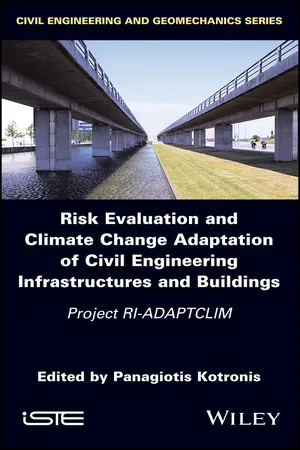
Risk Evaluation And Climate Change Adaptation Of Civil Engineering Infrastructures And Buildings
Project RI-ADAPTCLIM
- English
- ePUB (mobile friendly)
- Available on iOS & Android
Risk Evaluation And Climate Change Adaptation Of Civil Engineering Infrastructures And Buildings
Project RI-ADAPTCLIM
About This Book
This book brings together a selection of the scientific results of the RI ADAPTCLIM project (International Network on Risk Assessment and Climatic Adaptation of Civil Engineering and Buildings Works). Funded by the Pays de la Loire region in France as part of the 2014 Stratégie Internationale call for projects, research teams from the scientific group LiRGeC (ECN, UN, IFSTTAR, CSTB) and several international partners contributed their human, experimental and digital resources. RI-ADAPTCLIM was established to study the short- and medium term effects of climatic conditions on buildings, infrastructures and the ground. Following an integrated, interdisciplinary and multi-physics approach, the researchers proposed decision support tools that would increase the resilience of structures and buildings against the impact of hazards due to climate change.
Frequently asked questions
Information
1
Consideration of Seasonal Temperature Changes in the French Pavement Design Method
1.1. Introduction
Table of contents
- Cover
- Table of Contents
- Preface
- 1 Consideration of Seasonal Temperature Changes in the French Pavement Design Method
- 2 Study of the Behavior of Offshore Wind Turbine Monopiles under Monotonic and Cyclic Lateral Loading
- 3 Carbonation of Concrete in a Climate Change Context
- 4 A Method for Estimating Suffusion Susceptibility of a Compacted Dam Core from Construction Data
- List of Authors
- Index
- End User License Agreement